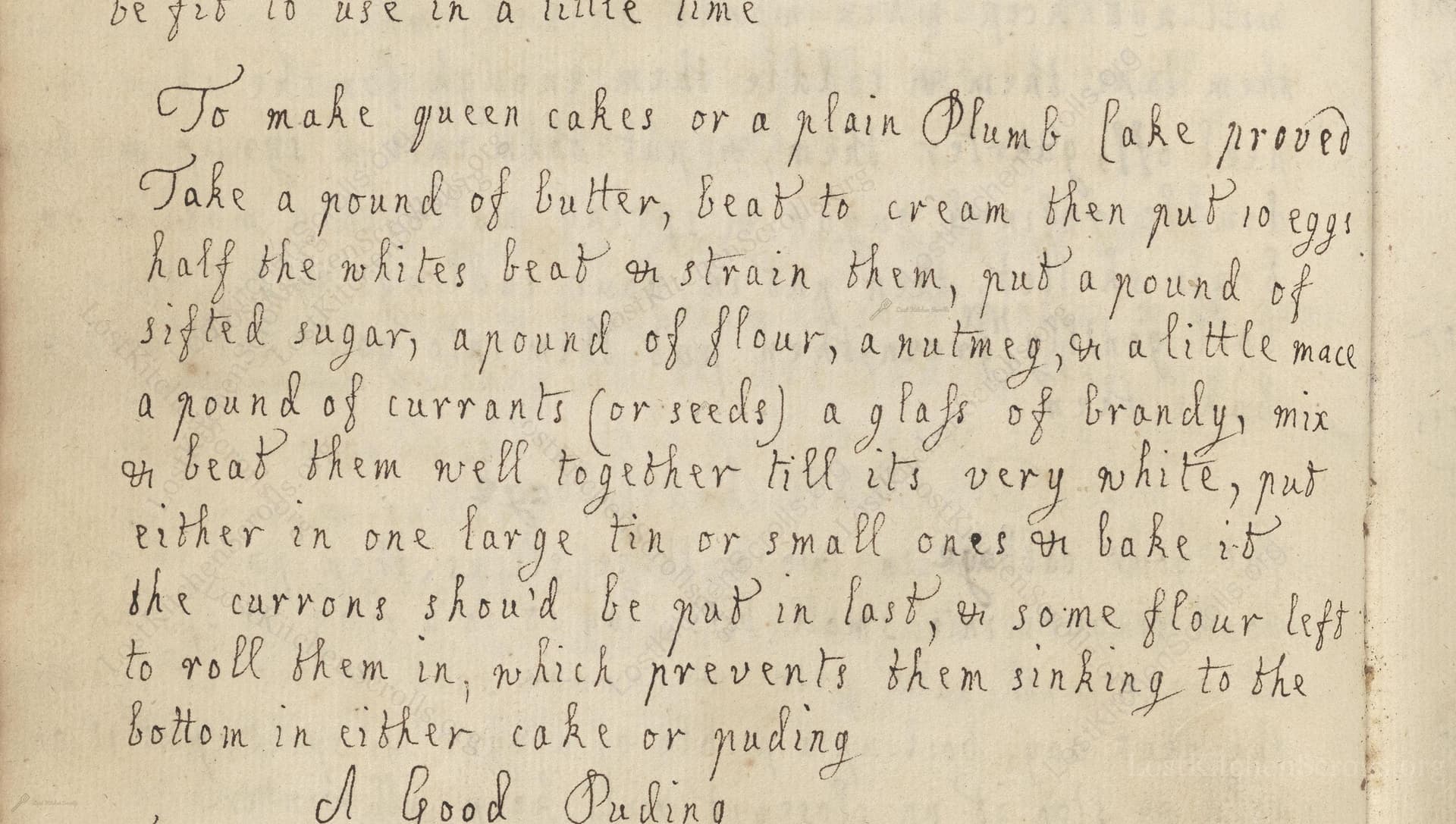To Make Queen Cakes Or A Plain Plumb Cake Proved
From the treasured pages of Cookbook of 1720
Unknown Author

To Make Queen Cakes Or A Plain Plumb Cake Proved
"Take a pound of butterr, beat to cream then put 10 eggs half the whites beat or strain them, put a pound of sifted sugar, a pound of flour, a nutmeg, or a little mace a pound of currants (or seeds) a glass of brandy, mix or beat them well together till its very white, put either in one large tin or small ones & bake it the currons shou'd be put in last, or some flour left to roll them in, which prevents them sinking to the bottom in either cake or puding"
Note on the Original Text
The recipe is written in the typical narrative style of the 18th century, giving proportions for a standard cake but with much left to the cook’s judgement—quantities are often by weight (a pound) and there’s little mention of oven temperature or baking time. Spelling is inconsistent: 'plumb' for 'plum' and 'currons' for 'currants' are typical old forms, and punctuation is sparse. These recipes were shared among skilled household cooks who knew culinary basics, so directions are compact, trusting in the baker’s intuition.

Title
Cookbook of 1720 (1720)
You can also click the book image above to peruse the original tome
Writer
Unknown
Era
1720
Publisher
Unknown
Background
Step back to the early 18th century and discover a delightful treasury of recipes and culinary secrets, where traditional flavors meet timeless technique—a feast for curious cooks and history lovers alike.
Kindly made available by
Folger Shakespeare Library
This recipe originates from early 18th-century British manuscripts, around 1720, at a time when rich cakes like queen cakes and plum cake were festive centerpieces for celebrations. Queen cakes, lighter and smaller than traditional plum cake, were often baked in small tins and served at tea tables—a sign of growing leisure and refinement among the upper classes. The method reveals the growing familiarity with sugar, dried fruits, spices—luxury ingredients increasingly available due to global trade. The inclusion of brandy reflects both flavoring and preservation practices of the period.

The baker would have used a large wooden bowl for creaming the butter and mixing, with a sturdy wooden spoon as the primary utensil. Eggs would be beaten using a hand whisk or bundle of twigs. Flour and sugar would be measured on simple scales or by eye, and currants tossed in flour by hand. Baking was done in metal or earthenware tins, placed in a wood-fired oven or before a hearth, monitored by experience rather than precise heat control.
Prep Time
25 mins
Cook Time
1 hr 15 mins
Servings
16
We've done our best to adapt this historical recipe for modern kitchens, but some details may still need refinement. We warmly welcome feedback from fellow cooks and culinary historians — your insights support the entire community!
Ingredients
- 1 lb unsalted butter
- 10 large eggs (use only 5 whites or strain out half)
- 1 lb caster sugar
- 1 lb plain flour
- 1/2 whole nutmeg, grated, or 1/2 tsp ground nutmeg (or a pinch of ground mace)
- 1 lb dried currants (or substitute sultanas, raisins, or mixed peel)
- 2 fl oz brandy
- Extra flour for tossing currants
Instructions
- Begin by creaming 1 lb of unsalted butter until light and fluffy.
- In a separate bowl, whisk 10 large eggs, removing half of the whites or straining them out for a richer batter.
- Gradually add the eggs to the butter, then mix in 1 lb of caster sugar.
- Sift in 1 lb of plain flour along with freshly grated nutmeg (about half a nut, or substitute 1/2 tsp ground nutmeg) or a pinch of ground mace.
- Prepare 1 lb of dried currants (or substitute with raisins if necessary), tossing them in a small amount of flour to help prevent sinking during baking.
- Stir the brandy (about 2 fl oz) into the mixture, then gently fold in the currants.
- Mix thoroughly, aiming for a pale, thick batter.
- Pour into a large cake tin lined with parchment or divide among small muffin tins for individual queen cakes.
- Bake at 340°F (fan 300°F) until golden and a skewer comes out clean: about 25–30 minutes for small cakes or 1–1.5 hours for a large cake.
Estimated Calories
390 per serving
Cooking Estimates
Preparing the batter and lining the tin takes about 25 minutes. Baking time is around 1 hour 15 minutes for a large cake, or about 30 minutes for small cakes. Each slice or small cake has about 390 calories, assuming you cut the large cake into 16 servings or make 16 small cakes.
As noted above, we have made our best effort to translate and adapt this historical recipe for modern kitchens, taking into account ingredients nowadays, cooking techniques, measurements, and so on. However, historical recipes often contain assumptions that require interpretation.
We'd love for anyone to help improve these adaptations. Community contributions are highly welcome. If you have suggestions, corrections, or cooking tips based on your experience with this recipe, please share them below.
Join the Discussion
Rate This Recipe

Den Bockfisch In Einer Fleisch Suppen Zu Kochen
This recipe hails from a German manuscript cookbook compiled in 1696, a time whe...

Die Grieß Nudlen Zumachen
This recipe comes from a rather mysterious manuscript cookbook, penned anonymous...

Ein Boudain
This recipe comes from an anonymous German-language manuscript cookbook from 169...

Ein Gesaltzen Citroni
This recipe, dating from 1696, comes from an extensive anonymous German cookbook...
Browse our complete collection of time-honored recipes



